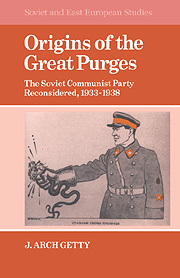Book contents
- Frontmatter
- Contents
- List of tables
- Preface
- Introduction: the Great Purges as history
- 1 The Communist Party in the thirties
- 2 What was a purge?
- 3 The Verification of Party Documents of 1935: a case study in bureaucratic ineptitude
- 4 Radicalism and party revival
- 5 Radicalism and enemies of the people
- 6 The crisis matures: 1937
- 7 Epilogue: the Ezhovshchina
- Conclusion: some observations on politics in the thirties
- Appendix: the Kirov assassination
- Bibliographic essay
- Notes
- Index
- SOVIET AND EAST EUROPEAN STUDIES
Appendix: the Kirov assassination
Published online by Cambridge University Press: 23 September 2009
- Frontmatter
- Contents
- List of tables
- Preface
- Introduction: the Great Purges as history
- 1 The Communist Party in the thirties
- 2 What was a purge?
- 3 The Verification of Party Documents of 1935: a case study in bureaucratic ineptitude
- 4 Radicalism and party revival
- 5 Radicalism and enemies of the people
- 6 The crisis matures: 1937
- 7 Epilogue: the Ezhovshchina
- Conclusion: some observations on politics in the thirties
- Appendix: the Kirov assassination
- Bibliographic essay
- Notes
- Index
- SOVIET AND EAST EUROPEAN STUDIES
Summary
It is widely asserted that Stalin conspired in the assassination of Serge Kirov in December 1934. Yet the evidence for Stalin's complicity is complicated and at least secondhand. In fact, if one traces the assertion that Stalin killed Kirov to its origins, one finds that, before the Cold War, no serious authority argued that Stalin was behind the assassination. The KGB defector Alexander Orlov was the first to make such a claim in his dubious 1953 account. Boris Nicolaevsky repeated the story in his influential 1956 essays (his 1936 “ Letter of an Old Bolshevik” had not accused Stalin), and it has since been widely accepted in Western academic and Soviet dissident circles.
Equally interesting is a list of those who did not believe Stalin organized the crime. Neither the Old Bolshevik of 1936 nor Nikita Khrushchev implicated Stalin. Khrushchev only said that there was much that was “mysterious” about the incident. At the height of his power, he could easily have charged Stalin with the crime had he wanted to. He blamed Stalin directly for the deaths of Rudzutak, Kosior, Eikhe, and other Politburo members, but not Kirov. Leon Trotsky, like Grigori Tokaev, believed that the assassination was really the work of misguided young oppositionists. G. Liushkov, an NKVD defector who outranked Orlov and Krivitsky, told his Japanese protectors that Stalin was not involved. Most recently, Adam Ulam noted that Stalin had little to gain from the killing.
- Type
- Chapter
- Information
- Origins of the Great PurgesThe Soviet Communist Party Reconsidered, 1933–1938, pp. 207 - 210Publisher: Cambridge University PressPrint publication year: 1985



